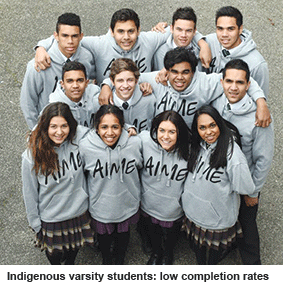 A rise in indigenous (aboriginal, equivalent to India’s scheduled castes and tribes) student enrolments in Australia should not obscure the need for “culturally appropriate and continuous support” to improve low completion rates, an academic has cautioned.
A rise in indigenous (aboriginal, equivalent to India’s scheduled castes and tribes) student enrolments in Australia should not obscure the need for “culturally appropriate and continuous support” to improve low completion rates, an academic has cautioned.
Recent federal government figures show that aboriginal and Torres Strait islander enrolments grew 7.6 percent in the first half of 2015. Universities Australia says this, along with a rise in enrolments for disadvantaged students, show that the removal of student number caps coupled with ongoing support programmes “continue to drive an expansion of access… for traditionally under-represented groups”.
Yet there remain calls for universities and the government to address low graduation rates among Indigenous students. A 2015 paper for the Australian Council for Educational Research found that among students who began courses in 2005, completion rates were 47 percent for Indigenous students against 74 percent for the non-indigenous.
Indigenous students are seen as more likely to experience financial pressures, particularly if they have travelled long distances from rural homes to study in cities. Critics argue that payments from Abstudy, the federal government financial support programme for Indigenous students, have failed to keep pace with cost of living increases and claim that other support has been cut back.
Belinda Robinson, chief executive of Universities Australia, explains that in 2011, the organisation produced a best practice framework for “indigenous cultural competency in Australian universities”, which “was developed in partnership with aboriginal and Torres Strait islander people and has been an invaluable resource” in sharing successful strategies.
There have been a number of appointments of Indigenous senior staff, including Shane Houston at the University of Sydney, the first Indigenous person to be appointed to a deputy vice chancellor post. Peter Buckskin, a Narungga male from the Yorke Peninsula in South Australia, is dean of Indigenous scholarship, engagement and research at the University of South Australia and chair of the National Aboriginal and Torres Strait Islander Higher Education Consortium.
Buckskin says the work of universities includes “university familiarisation programmes for indigenous high school students, lifting the numbers of indigenous academics… including promoting indigenous leadership to senior executive positions, building indigenous content into the curriculum and campus life, offering cultural awareness professional development for academics and creating culturally appropriate spaces on campus where indigenous students can go for support”. Despite the rise in enrolments, Indigenous students comprise only 1.1 percent of all students.
Prof. Buckskin highlights the rising number of Indigenous students completing high school. He says there’s “obviously still some way to go” before university enrolments are “on par with the fact that our people make up 3 percent of the Australian population — but these recent trends of strong growth are heading in the right direction”.